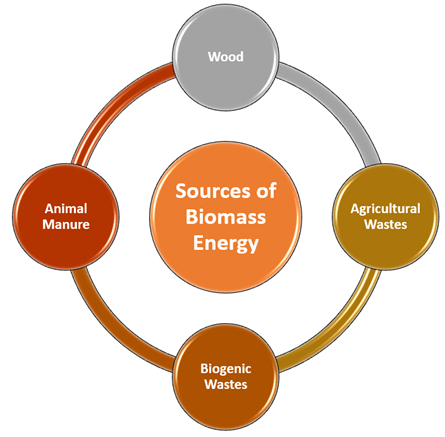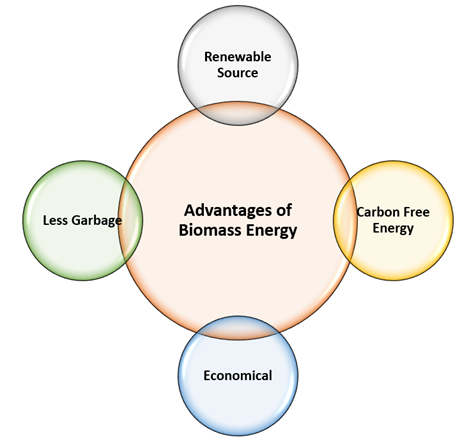Biomass is a form of renewable energy that is obtained from organic fuels like forest debris, scrap lumber, crops, manures and some types of waste residues. The energy derived from these organic fuels is eco-friendly and carbon-neutral energy that can be used in small scale as well as in large scale applications. Since waste residues will exist always, it would provide an uninterrupted source of energy. If managed properly, one can have continuous supply from the forests and residual matter of crops, which can be used to produce Biomass Energy.

Source: © Kgtoh | Megapixl.com
What is Biomass Power?
Biomass power is a process of electricity generation from renewable organic fuels. Biomass power generation is a carbon-neutral electricity generation process that neither changes greenhouse gas' concentration in the atmosphere nor harms the environment. Biomass power plants are used to convert heat energy produced from the burning of organic fuels to electric energy. In biomass power plants, organic waste is burned to produce steam that is ultimately used to rotate mechanical turbines and generate electricity. The level of emission in biomass energy plants is much less than that of the burning of fossil fuels that release an enormous amount of emissions into the atmosphere.
What are the different sources of Biomass Energy?
There are numerous sources of biomass energy ranging from wood to agricultural wastes. Let us have a look at these resources to have a clear idea.

Source: Copyright © 2021 Kalkine Media
- Wood: Wood and wood processing wastes are the most common biomass energy sources that are used to produce biomass energy for ages. Wood pellets, wood chips, firewood, sawdust, black liquor and lumber sawdust are some of the most prominent biomass energy sources.
- Agricultural Wastes: Agricultural wastes including sugarcane, woody plants, algae, food processing residue, soybeans, corns are widely used for producing biomass energy.
- Biogenic Wastes: Biogenic wastes, including municipal waste like cotton, wool, paper, wood waste, food etc., comes under the biogenic fuel category to produce biomass energy.
- Animal Manure: Animal waste after drying and converting to manure can also be used for biomass energy production.
How can one harness Biomass Energy?
Biomass is an organic-sourced form of energy which means the energy is derived from the materials that come from living organisms like animals and plants. Plants, wood and waste are the most common form of fuels used to create biomass energy. Plants absorb the sun's energy to convert water and carbon dioxide into nutrients through a process known as photosynthesis. The energy from these nutrients can be derived in the form of biomass energy and can be harnessed in several ways. Let us look into the different processes of energy harnessing briefly.
- Direct Combustion: It is the most common and popular method of harnessing biomass energy. The process involves the burning of biomass fuels to generate heat energy that can be directly used for heating purposes in industries, homes or for producing steam for generating electricity through mechanical turbines.
- Thermochemical Conversion: This process includes the thermal decomposition of biomass feedstocks in closed and pressurized vessels, commonly known as gasifiers. There are various types of conversion processes, including pyrolysis and gasification, which mainly differ in the amount of oxygen and temperature variation during the conversion process.
- Pyrolysis involves heating of organic matter at 400-500 degree Celsius in the absence of oxygen to produce renewable diesel, bio-oil, hydrogen, methane etc.
- Gasification involves heating organic matter at 800-900 degrees Celsius with controlled oxygen flow to produce carbon monoxide and hydrogen-rich syngas that can be used as a fuel for diesel engines and generate electricity for turbines.
- Chemical Conversion: It is a transesterification process that can be used to convert animal fats, vegetable oils and greases into fatty acid methyl esters, used to produce biodiesel.
- Biological Conversion: The process includes fermentation of biomass to convert it into ethanol. Ethanol can be used as a vehicle fuel.
Summary
- Biomass is a form of renewable energy obtained from organic fuels like forest debris, scrap lumber, crops, manure, and waste residues.
- Wood and wood processing wastes, agricultural wastes, biogenic wastes and animal Manure are some of the primary sources of biomass energy.
- Biomass energy can be harnessed into usable form by direct, thermochemical, chemical and biological conversion processes.
Frequently Asked Questions (FAQs):
What are the advantages of Biomass Energy?
There are various advantages of biomass energy. Let's glance at some of the major benefits in brief.

Source: Copyright © 2021 Kalkine Media
- Renewable Source: Biomass energy is a renewable source of energy that organic fuels can generate. Since our society consistently produces organic wastes, biomass energy would provide a continuous and interrupted source of energy.
- Carbon Free Energy: Biomass energy is a carbon-free source of energy as it releases the same amount of carbon dioxide in the atmosphere as taken up by plants during photosynthesis.
- Economical: Biomass is an economical source of energy. Where the production of fossil fuels requires a huge sum of investment, biomass energy generation requires very little investment.
- Less Garbage: It is an additional benefit of biomass energy. While producing a substantial amount of energy is also released the burden from the earth in the form of lower landfills.
What are the disadvantages of Biomass Energy?
Having a lot of advantages doesn't mean that biomass energy doesn't have any disadvantages. Let us discuss some of the most important disadvantages of biomass energy.
- Insufficient source: Biomass is a clean energy source of energy, but it is not sufficient to fulfil worldwide energy demands. However, it can be used in parallel with other renewable energy sources to fulfil the overall demand.
- Deforestation: Since wood and wood products are the ultimate source of biomass energy, there is a risk of deforestation with wider biomass energy usage.
- Space requirement: Biomass energy requires a lot of space. Finding such a huge space in urban areas is quite difficult, which limits its usage in such areas.
- Not an entirely clean energy source: Biomass is a carbon-neutral source of energy, but human and animal waste as biomass fuel produces a significant amount of methane gas, potentially raising global temperature.
 Please wait processing your request...
Please wait processing your request...